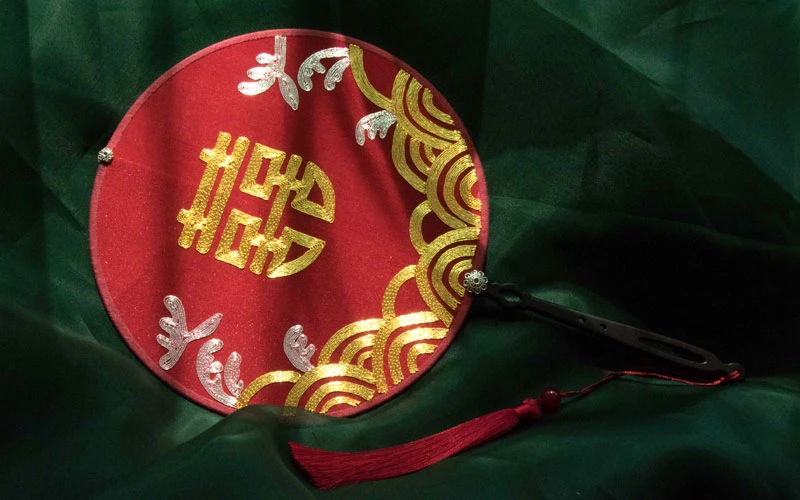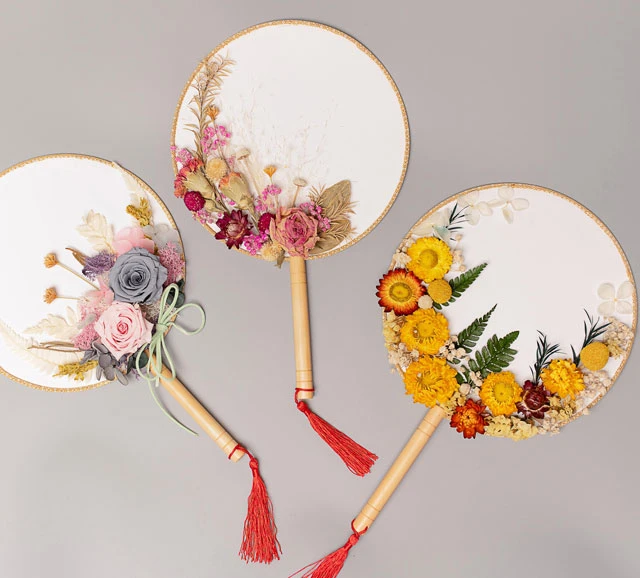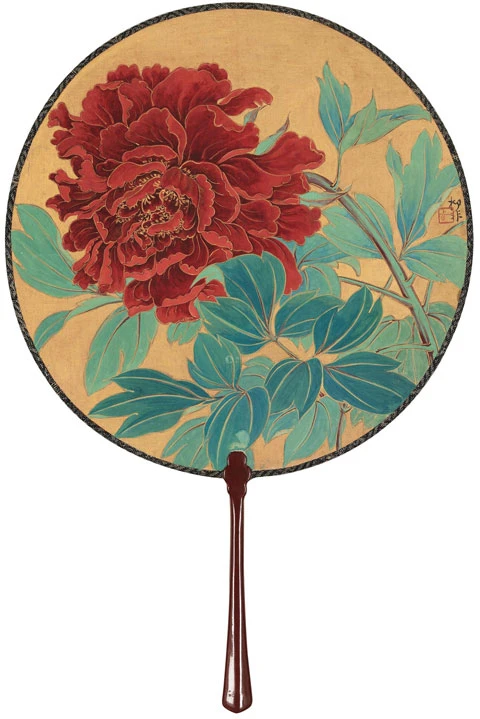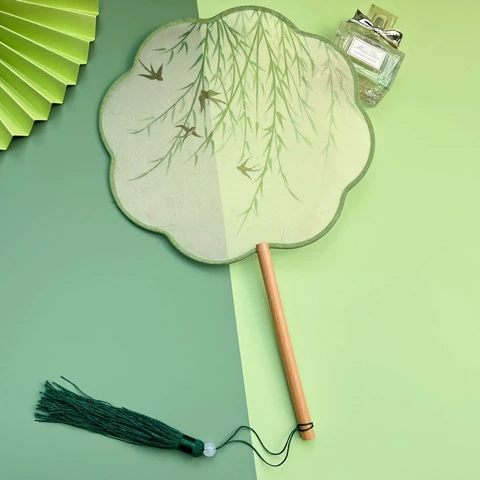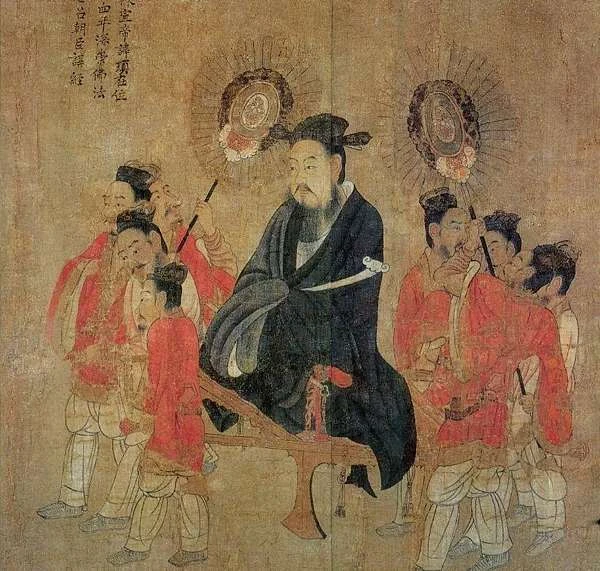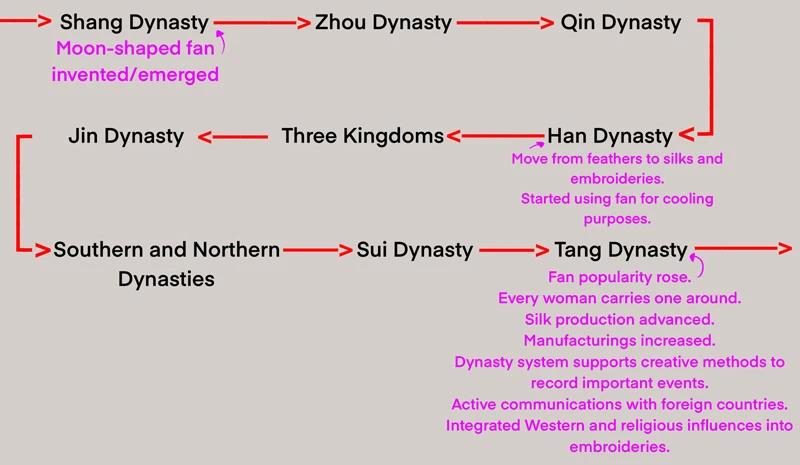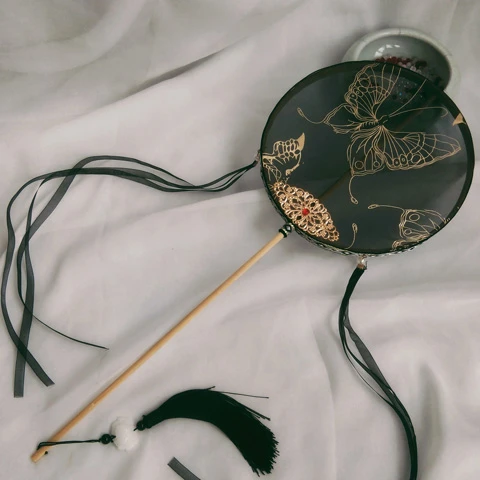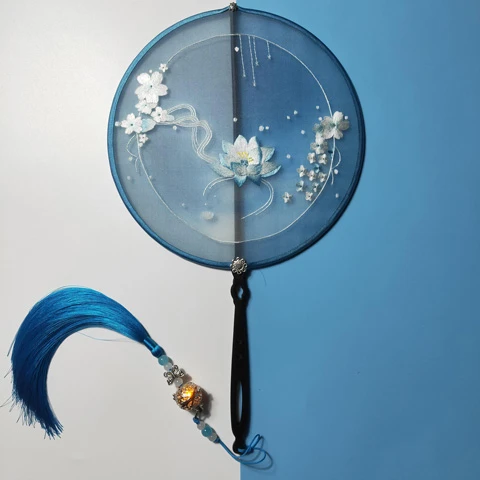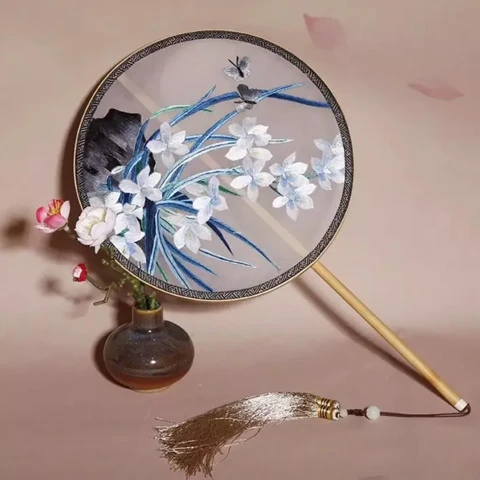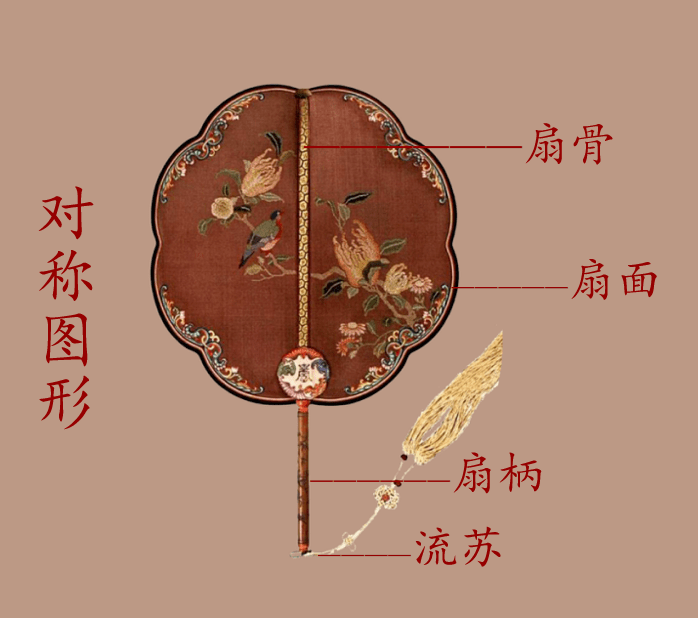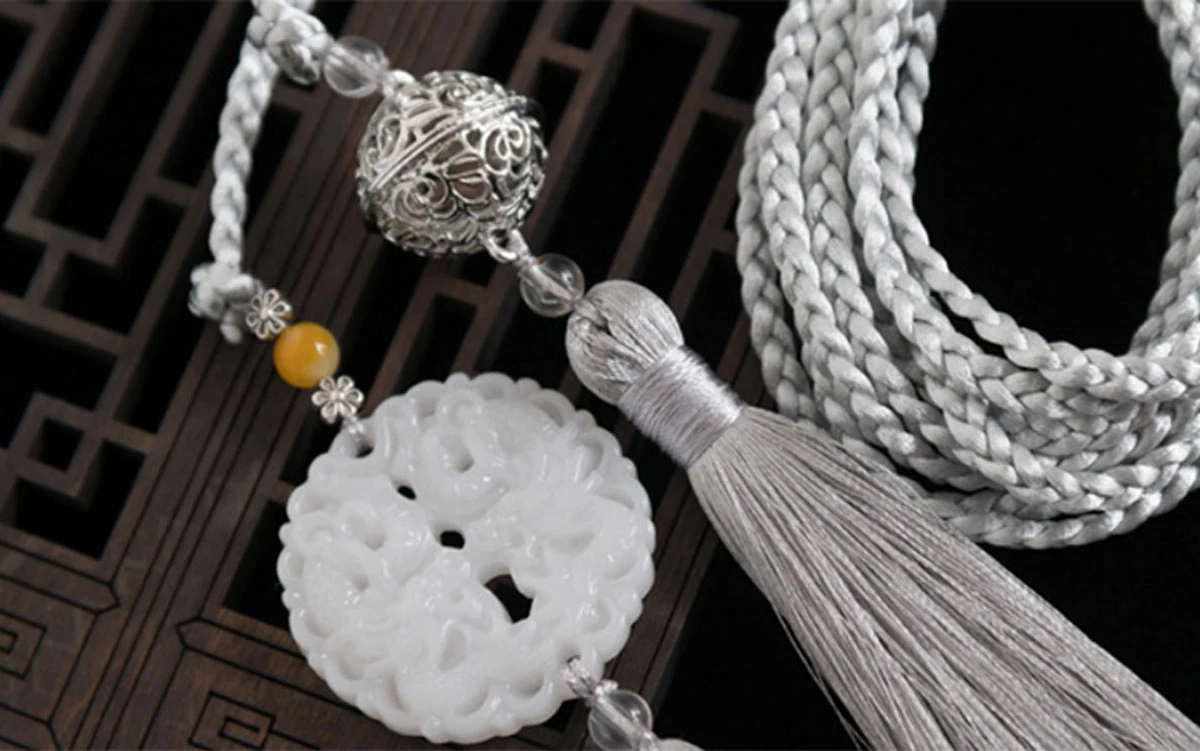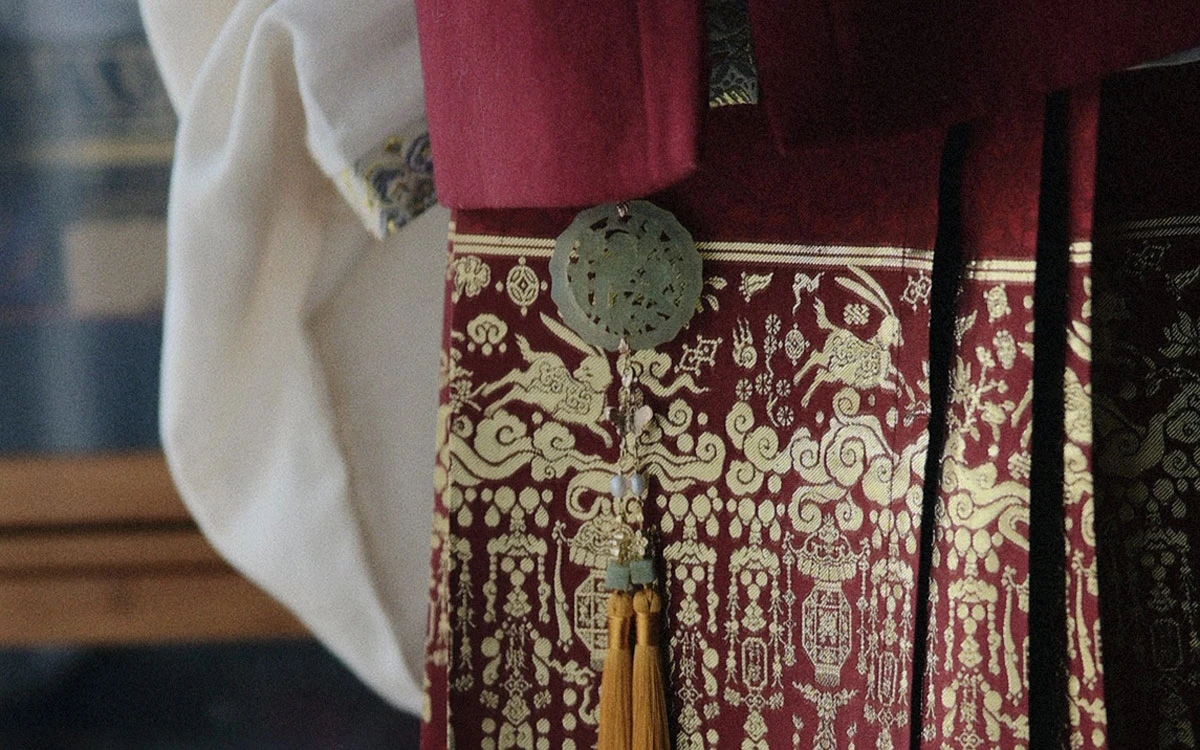Vocabulary
- Moon-shaped fan; 团扇 (tuánshàn). Also called 宫扇(gōng shàn), 纨扇 (wánshàn), 合欢扇 (héhuān shàn), a fan that is made from silks, embroideries, golds, beads, etc. later on into the period.
- Barrier fan; 障扇 (zhàng shàn) - one of the earliest version of fan from ancestors. Made with pheasant’s feathers and has a long handle. Also known as 长扇 (Chǎng shàn)、掌扇 (zhǎng shàn)、五明扇 (wǔ míng shàn). It is under the category of moon-shaped fan (团扇).
- Imperial carriage; 辇 (niǎn). Also known as chariot. This is the earlier versions of traveling vehicles primarily used by prestigious people for ceremonial processes, imperial tours, and any other formal occasions. The usage of this is closely related to imperial court instead of public, such as for emperor, queen’s mother, empress, and imperial concubines. These types of carriage are still man-drawn, and are made of simple designs with either a cushion or a chair for the individual seating on it.
History of Tuanshan
The moon-shaped fan, also known as 团扇 (tuánshàn), is a traditional handicraft tool of the Han people from ancient China. It consists of four main components: the fan's frame, handles (usually short in length), the fan's surface (made of semi-transparent or opaque silk fabric adorned with embroidery), and tassels.
Since ancient times, the moon-shaped fan has carried a profound meaning closely tied to the concepts of reunion, friendliness, and good fortune, beautifully captured in the sentence: "团圆友善, 吉祥如意 (tuányuán yǒushàn, jíxiáng rúyì)." The classic circular surface of the fan corresponds with the concept of "reunion (团圆美满),: representing the meaning of happy reunions and wishing for a harmonious relationship, whether it be with family or a loved one.
While the circular surface is one of the traditional shapes of the moon-shaped fan, people throughout the eras have expanded the options for shapes and designs. Any shapes are welcomed to be integrated into the moon-shaped fan, allowing for diverse artistic expressions while still maintaining the fundamental principle of symmetry and balance on both the left and right sides of the surface.
The moon-shaped fan has its initial origin in the early Shang Dynasty, although during that time, it was known by a different name. Instead of a "moon-shaped" fan, it was referred to as "障扇 (zhàngshàn)," which directly translates as "barrier fan." The barrier fan is categorized under the "moon-shaped" fan as one of its variations, but the materials and purpose of the barrier fan differ significantly.
Barier fans were crafted from colorful pheasant feathers rather than silk due to the era's limited access to silk-making. This distinguished them from the silk-based fans commonly seen today. The appearance and size of the barrier fan also deviated from those of the moon-shaped fan.
While the moon-shaped fan is primarily recognized as an accessory paired with hanfu attire and serves the fundamental function of bringing a slight cool breeze in hot weather, the barrier fan is not used for any of those purposes. In its earliest form, the barrier fan served its namesake - serving as a protective barrier. It was used to shield individuals from direct exposure to sunlight, rough wind, or even sand and other small particles carried by the wind when outdoors.
Initially, it was exclusively used by emperors during their travels. Servants would follow behind the imperial carriage, known as 辇 (niǎn), and the two standing on either side of the carriage would carry large barrier fans to block dust, sunlight, and wind coming from the sides.
Over time, the usage of barrier fans expanded beyond the imperial court, becoming accessible to commoners for similar protective purposes. However, carrying a fan of similar height every time one went outdoors was not practical. This possibly led to the evolution of the moon-shaped fan as we know it today. The size became smaller and lightweight, and the shape options also started expanding, allowing for various designs and embroideries to be displayed. Eventually, the moon-shaped fan became integrated into marriage customs for women, taking on new symbolism and cultural significance.
Moon-shaped fan is mentioned in poems and written text, one being Tang Dynasty Wang Changling's poem "Changxin Chou;"
唐·王昌龄《长信愁》: “奉帚平明秋殿开,且将团扇共徘徊。”
"With broom in hand, the autumn palace opens at dawn, Let us wander together with our round fans."
The Han Dynasty itself spans over 400 years of history and is divided into two periods: the Western Han (206 BC - 9 AD) and the Eastern Han (25-220 AD). It was during the later period of the Han Dynasty that the moon-shaped fan evolved.
During the Eastern Han Dynasty, there was a shift in the materials used for crafting moon-shaped fans. They expanded from feathers to utilizing silk (丝, sī), gauze (绢, juàn), and damask (绫罗, líng luó) for the fan's surface. However, silk was the popular option because it allowed them to use colorful silk threads and add various intricate embroideries onto the surface entirely based on their preferences.
During the Tang Dynasty, the moon-shaped fan became immensely popular among women. It not only served as an accessory but also as a practical tool for daily usage. The culture of the moon-shaped fan in the Tang Dynasty was influenced by various factors, including politics, economy, and foreign cultures.
Tang Dynasty is a period of remarkable growth where the country possesses strong national strength and political stability. It is a period of peak development for the feudal dynasties, which allows the country to foster artistic expressions such as illustrations and embroideries to capture social changes and reflect the dynamics of nature in society on the fan's surface.
The economy also undergoes significant growth, where the production rate in industries, including handicrafts, increases. Among them, the silk industry has a direct impact on the moon-shaped fan. The development of silk manufacturing and weaving techniques allows for more availability of silk materials, which allows craftsmen to create fans that are more refined and exquisite.
On the cultural aspect, during the enlightened period of the Tang Dynasty, people were given a greater degree of intellectual freedom and improvement in their mental outlooks. Besides expressing and recording things into images or sentences through embroideries on the fan, scholars and intellectuals are encouraged to express their ideas openly in their work, allowing for the exploration of new concepts.
During the Tang Dynasty, there was also active engagement with the outside world, which led to the influence of foreign cultures and ideologies on various aspects, including moon-shaped fan production. This resulted in a broader range of artistic expressions and themes on the fan's surface that reflected the richness and diversity of cultural influences. Thus, the culture and religious characteristics of the Western regions are also expressed in the designs of the fan.
In terms of religious development, the Tang Dynasty was also open and presented a tolerant attitude towards their existence. Confucianism, Buddhism, and Taoism are just some of the known ones that coexisted and interacted, contributing to a diverse religious landscape.
Nowadays, the moon-shaped fan remains popular among younger generations, particularly among hanfu enthusiasts. Holding a moon-shaped fan while dressed in hanfu is just one method to immerse individuals in the atmosphere of the prosperous Tang era or other dynastic periods.
Lastly, it is worth noting that historical records from the Song Dynasty referred to the moon-shaped fan as "fan" (扇子, shànzi). Not all texts might use the same term, though. It could be referring to the hand-held folding fan we are familiar with now, the moon-shaped fan, or a completely different fan when the text mentions "fan" based on the time period and the existence of multiple names to refer to one object.
Materials of Tuanshan
The fan consists of four main parts: the frame, handle, surface, and tassels. The surface of the fan is primarily made of materials such as bamboo, wood, paper, elephant teeth, tortoiseshell, emerald, and bird's feathers. If the fan is made of thin layer of silk for the surface then it is open for designs or poem embroideries.
Additional materials used include palm leaves, betel leaves, wheat straws, and bulrush.
The handle of the fan can be either vertically integrated on one side of the fan's surface for added support, which will look like the handle is splitting the surface in half from behind if the material for the surface is see-through. Together, the handle and fan frame form the skeleton or structural framework of the fan.
The handle comes in various lengths, with shorter handles being more common, although moon-shaped fans can have longer handles. The name remains the same, but handle lengths are influenced by cultural developments and consumer preferences.
When the surface of a moon-shaped fan is made of paper, it is more suitable for incorporating artwork through painting and calligraphy rather than embroidery. In such cases, the handle will extend to the end of the circular frame and come to a stop.
Additionally, the fan may feature tassels. In moon-shaped fans, a hole may be drilled at the end of the handle to attach various accessories, such as tassels, jade ornaments, beads, and more. The popular option is tassels. These accessories add decorative elements to the fan and enhance its aesthetic appeal.
Fan’s breakdown
- 扇骨 (shàngǔ) - fan's bone
- 扇面 (shànmiàn)- fan's surface/face
- 扇柄 (shàn bǐng) - fan's handle
- 流苏 (liúsū)- tassels
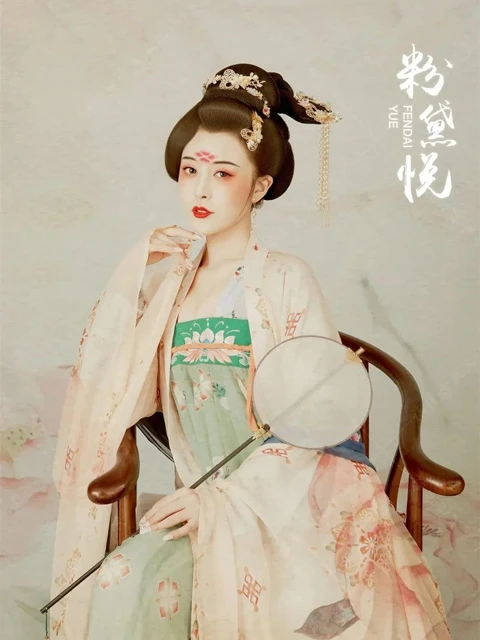
With long handles
Designs of Tuanshan
In general, moon-shaped fans can feature a variety of embroidery designs on their surface. The main idea behind these designs is to portray a subject and a few supporting objects that further enhance the subject's expression. The subject can be a noble figure from the palace or a common person from the streets. It can convey elegance and grandeur or capture the beauty of life and people.
Objects are used to support the subject and can include flowers, architectural structures, flowing rivers, mirages, or small animals. Some examples include breezes, orchids, and chrysanthemums, which add depth and contrast to the main subject. However, in contemporary times, moon-shaped fans often feature small animals like butterflies or flowers as the main subject, rather than a comprehensive artwork with various subjects and objects.
Furthermore, the surface of the fan can be left blank. This can be achieved by creating space between the subjects on the surface or by intentionally leaving a wide blank area. The blank space can also be used to incorporate written texts. While folding fans (折扇, zhéshàn) are commonly associated with written texts, moon-shaped fans can also feature one or two sentences, poems, or even a stamp.
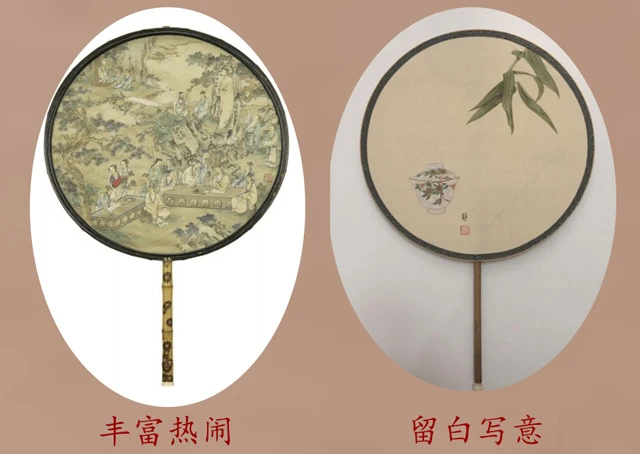
Right: with complete image; Left: not filling all space for poems
Shapes of Tuanshan
While the circular shape of the moon-shaped fan is the most commonly recognized, there have been other popular shapes that have been explored.
These include the round fan (圆形团扇, yuán xíng tuánshàn), petal-shaped fan (花瓣形团扇, huābàn xíng tuánshàn), banana-shaped fan (芭蕉式团扇, bājiāo shì tuánshàn), oval-shaped palace fan (椭圆形宫扇, tuǒyuán xíng gōng shàn), empress tree leaves palace fan (桐叶式宫扇, tóng yè shì gōng shàn), rectangle fan (长方形团扇, chángfāngxíng tuánshàn), square fan (方形团扇, fāngxíng tuánshàn), hexagon fan (六角团扇, liùjiǎo tuánshàn), and some less known shape such as sunflower (葵花, kuíhuā), plum blossom (梅花, méihuā), elliptical (扁圆, biǎn yuán), and crab apple (海棠,hǎitáng).
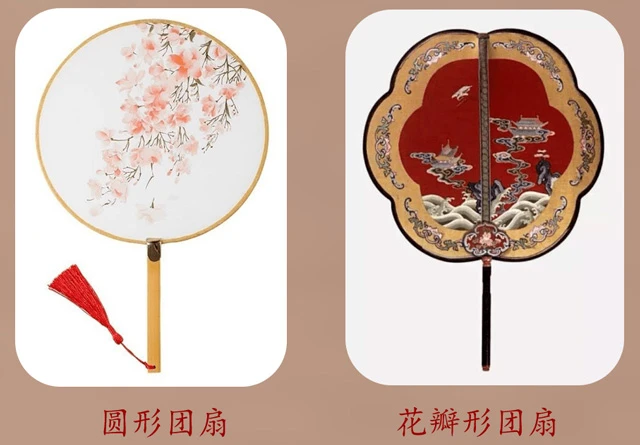
round fan & petal-shaped fan

banana-shaped fan & shaped palace fan
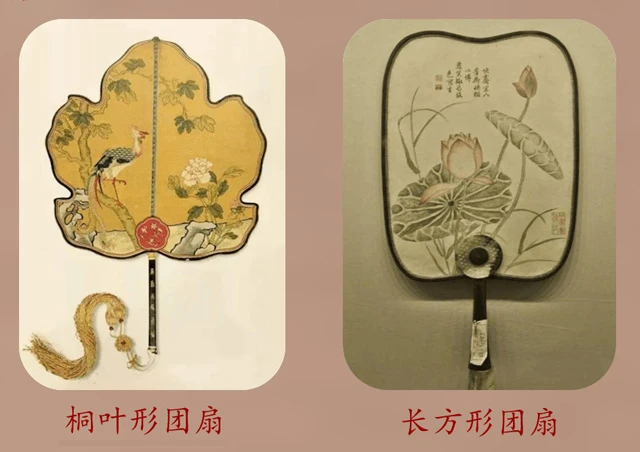
empress tree leaves palace fan & rectangle fan
